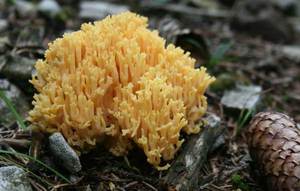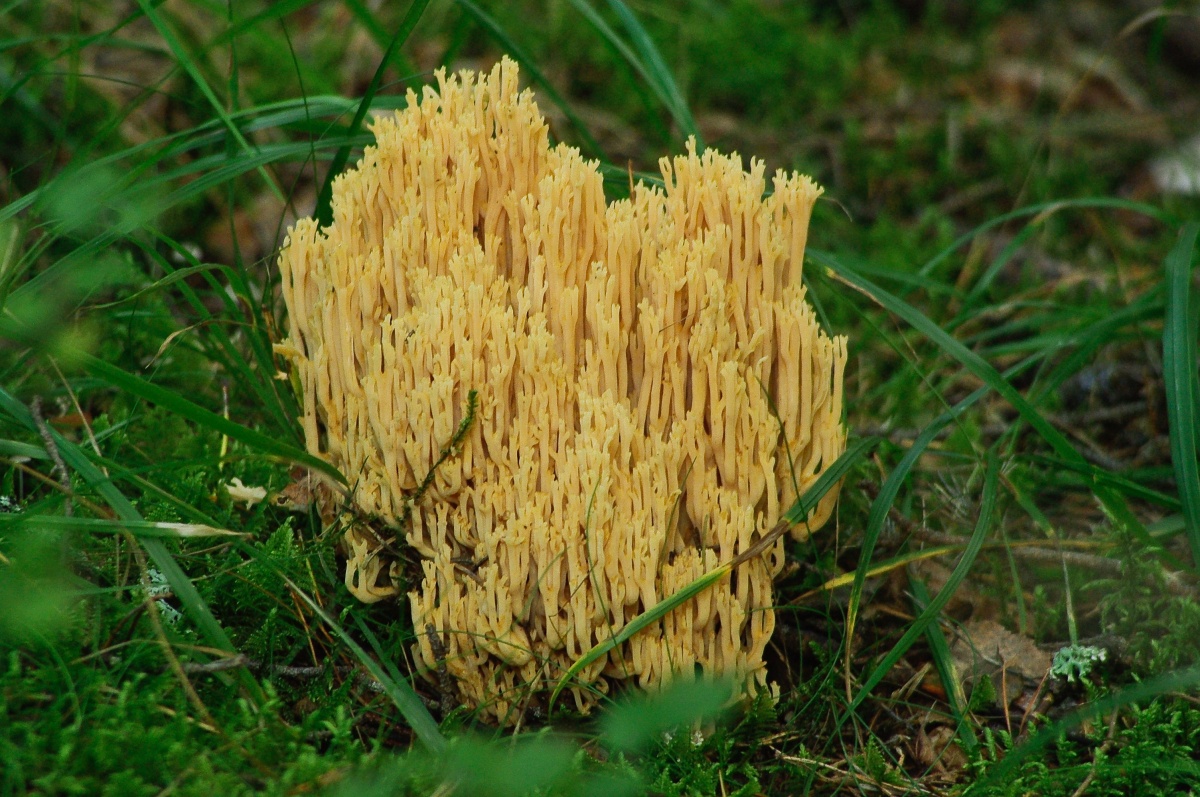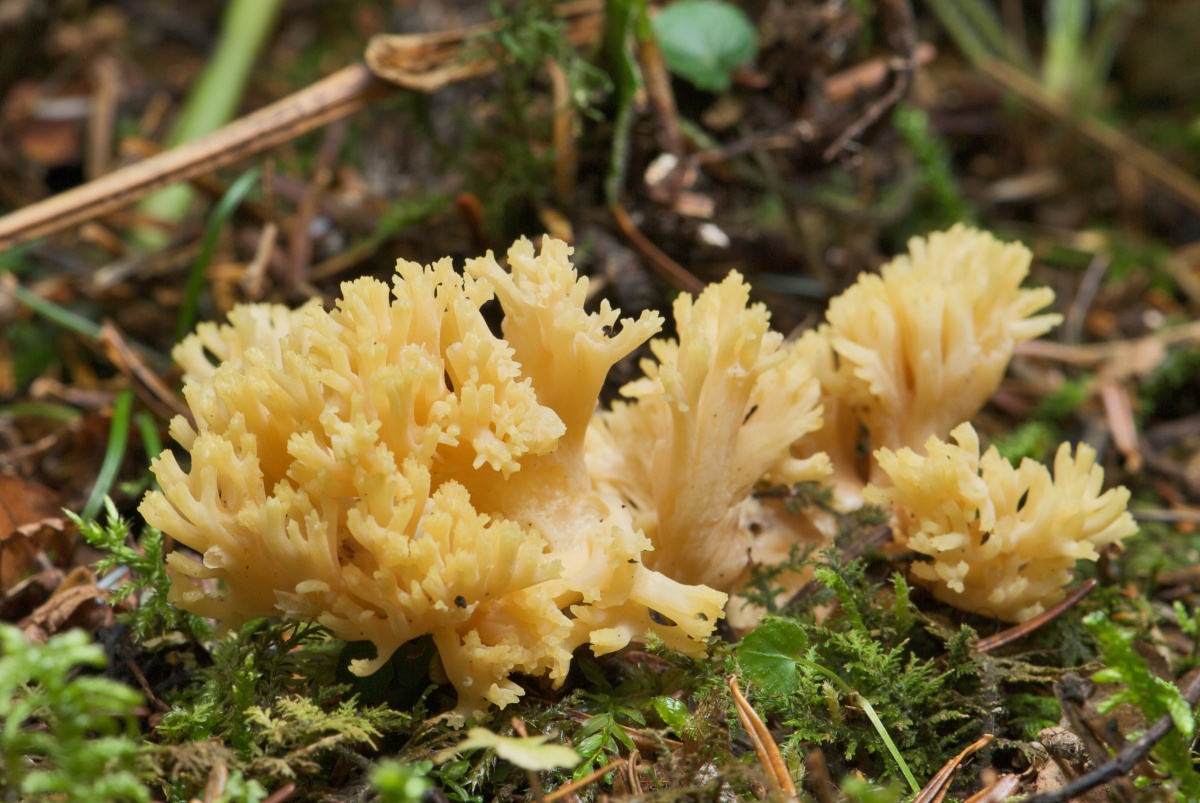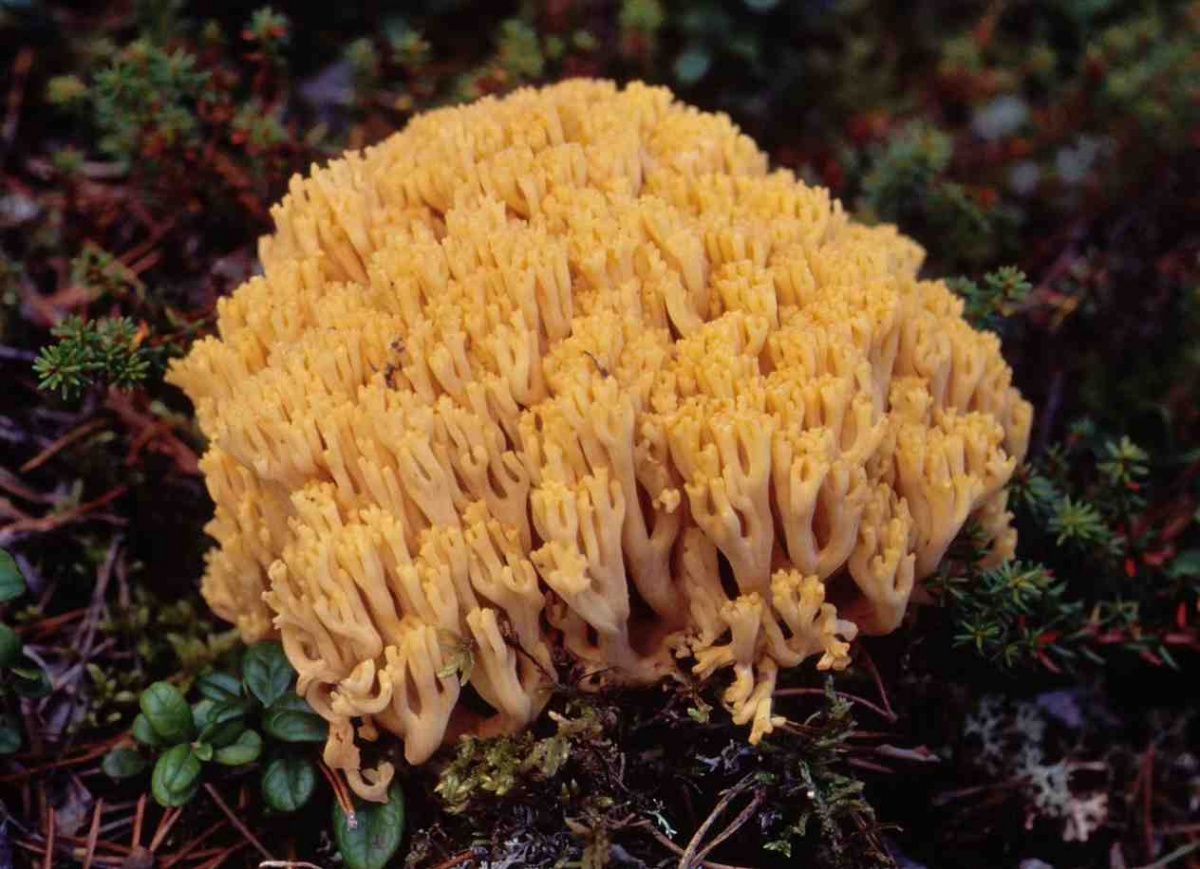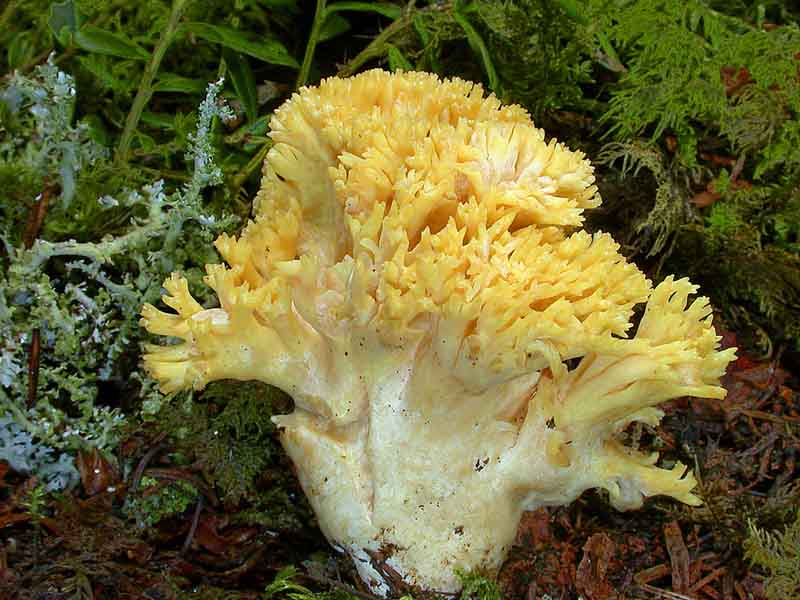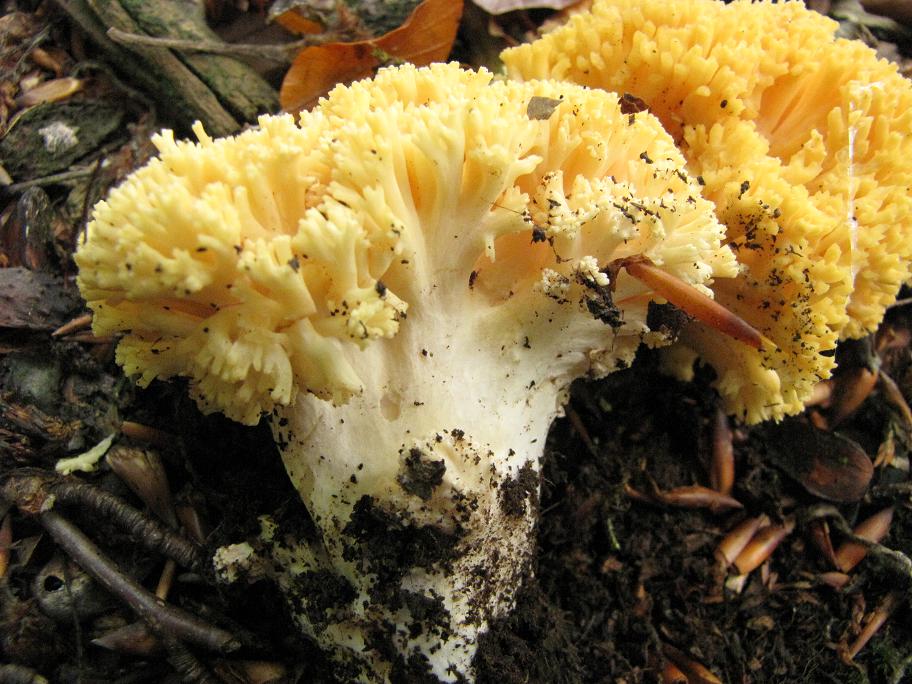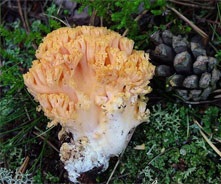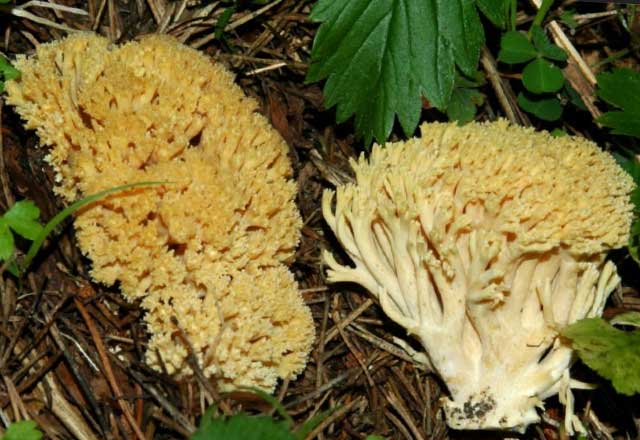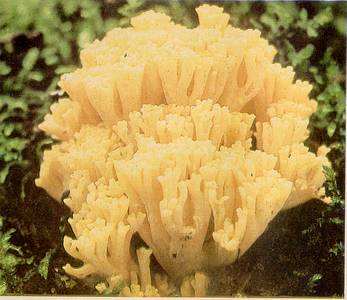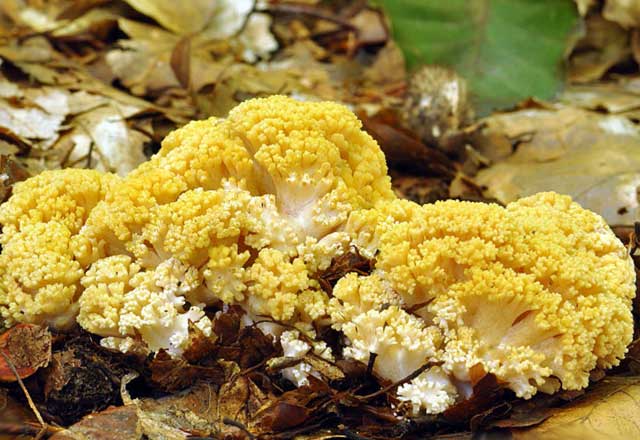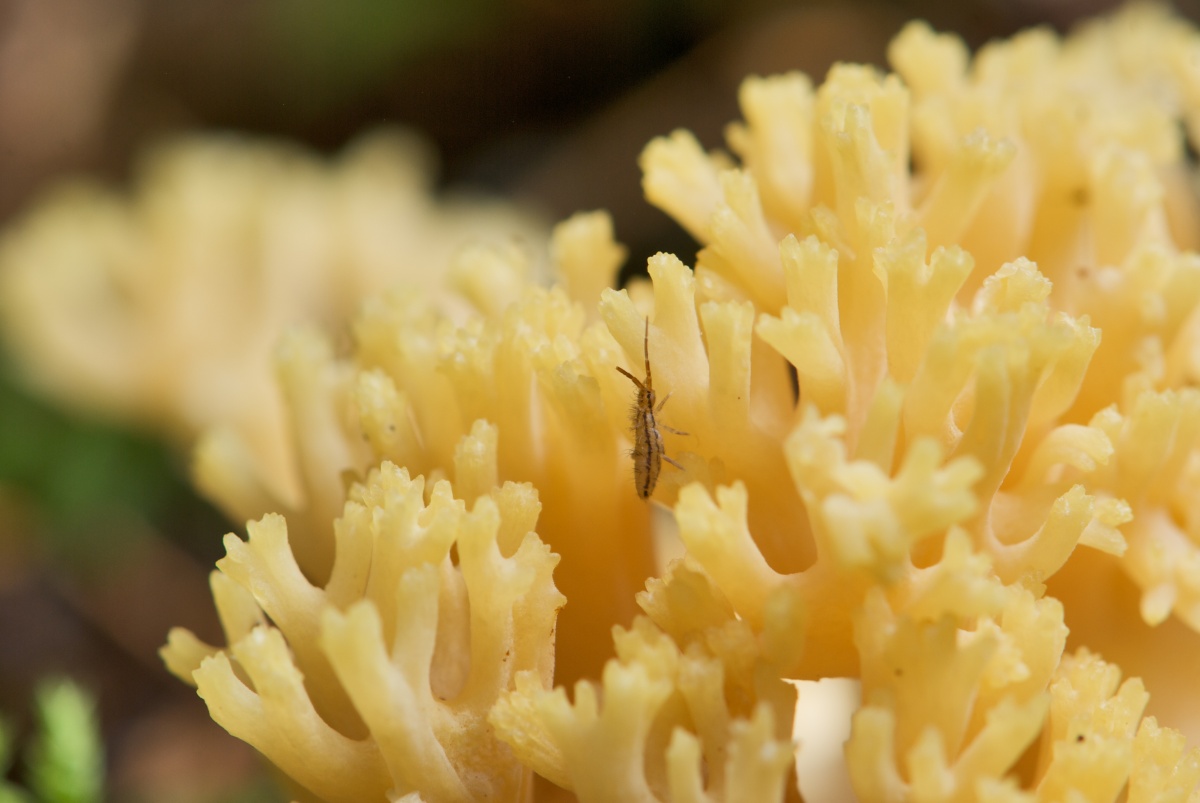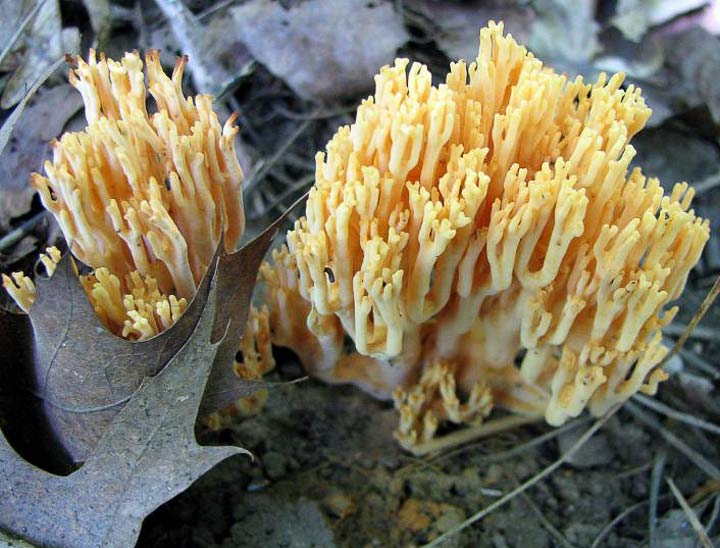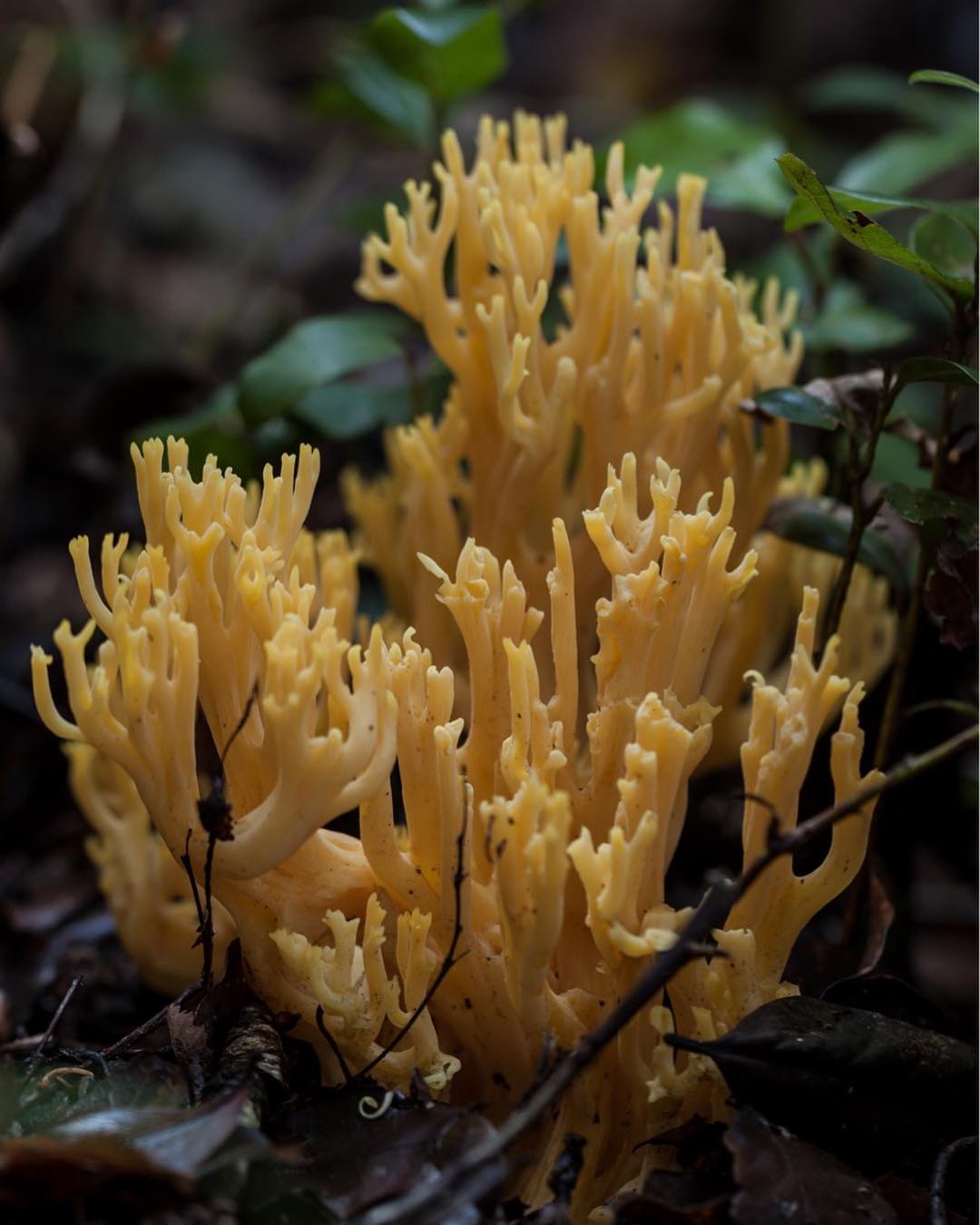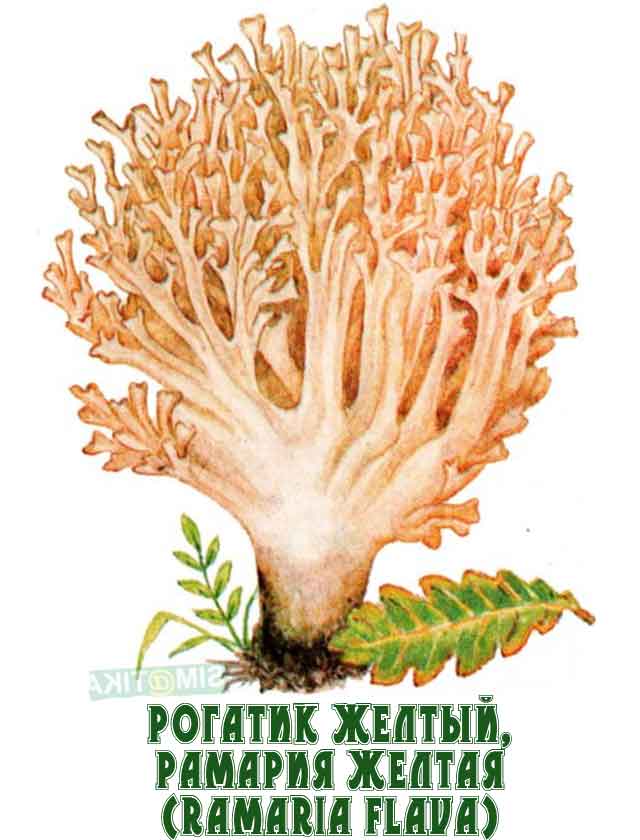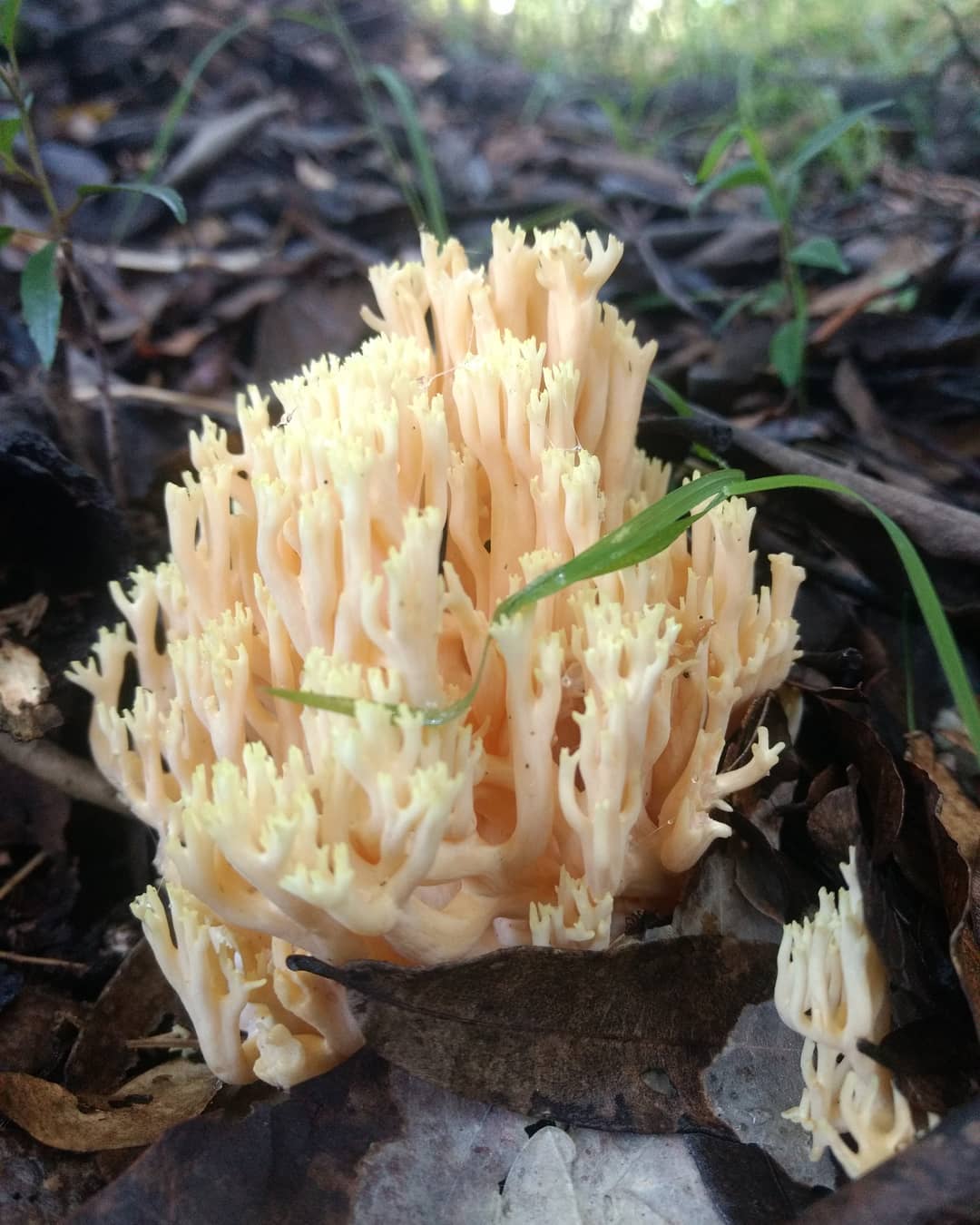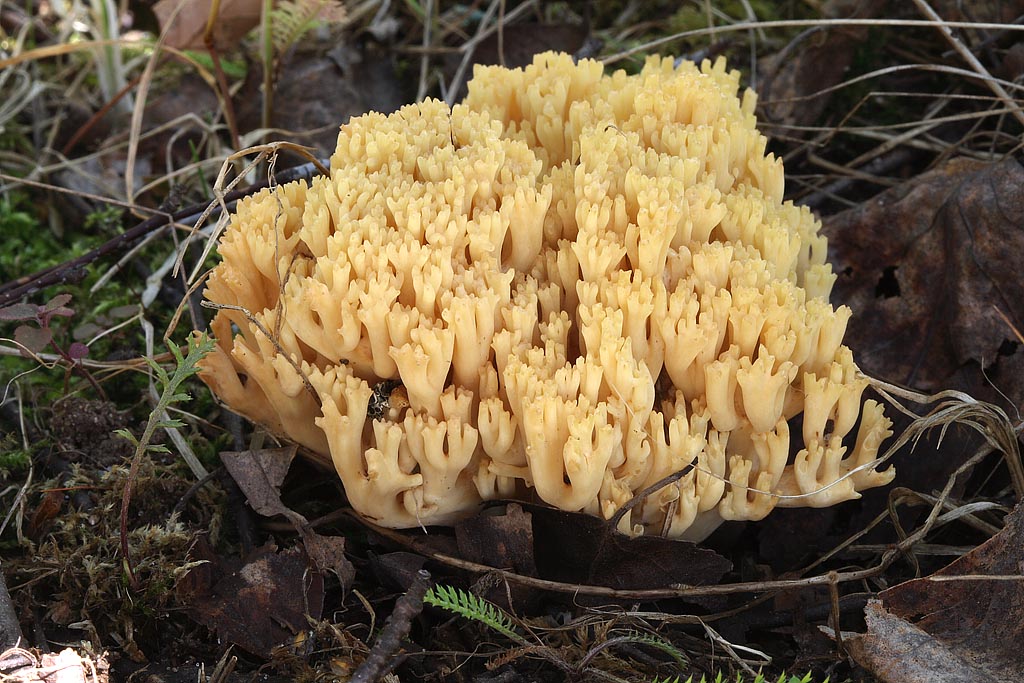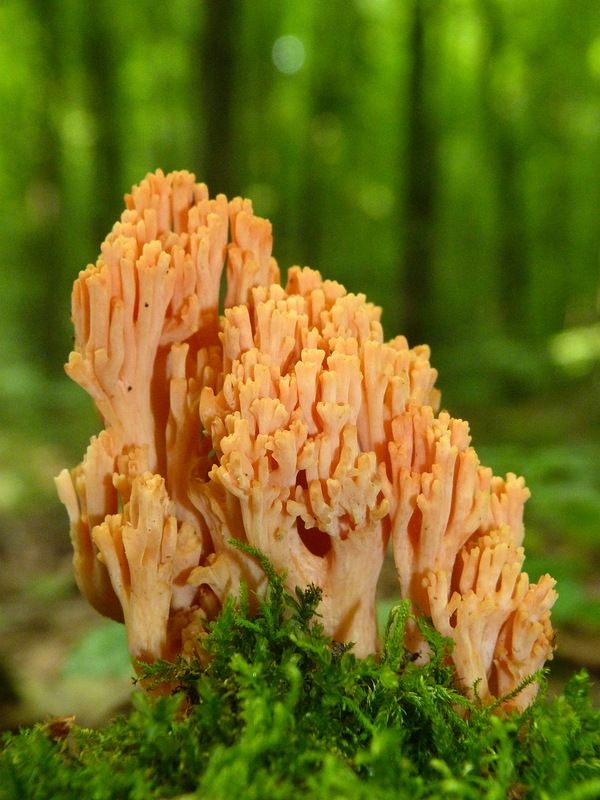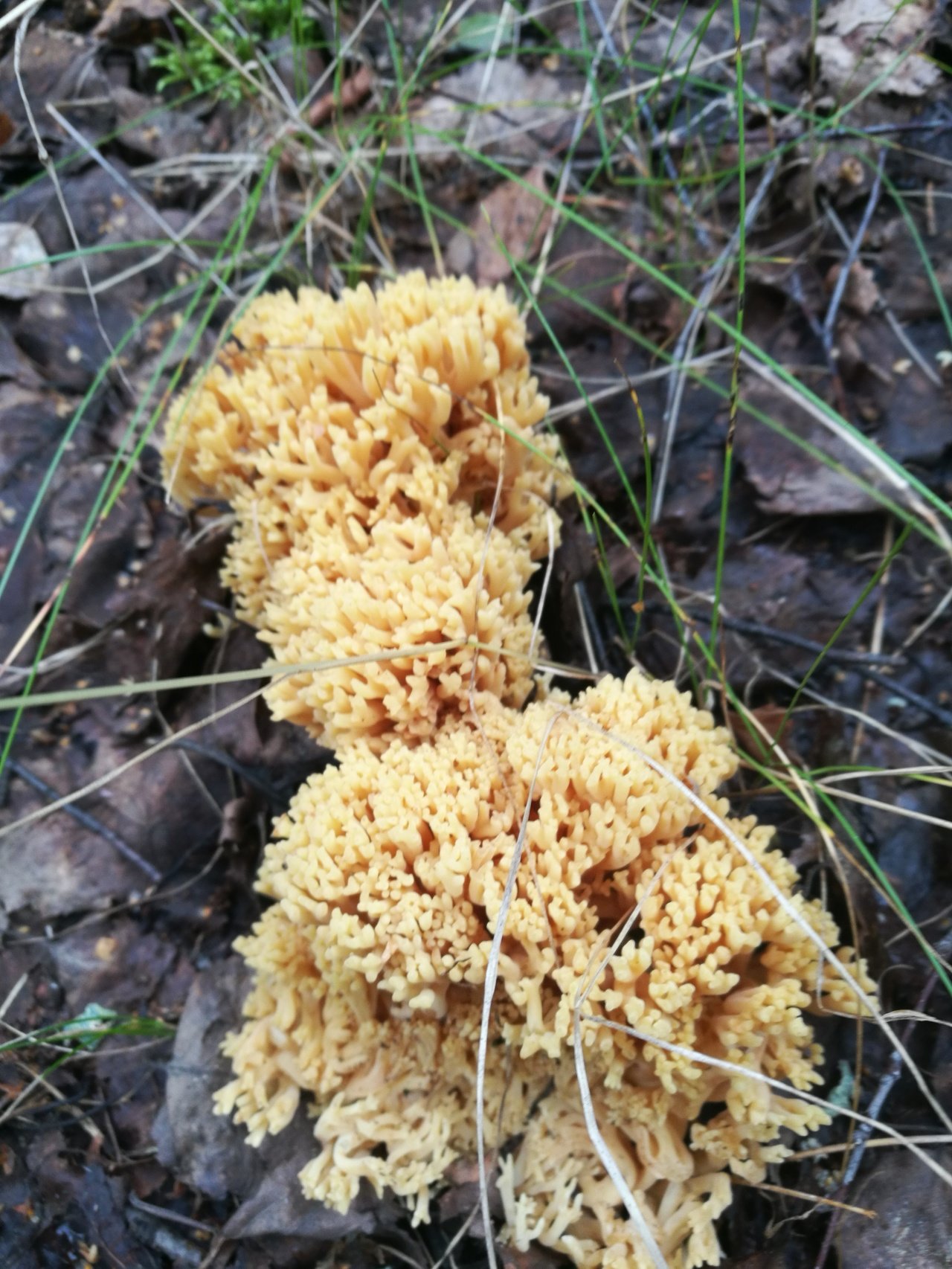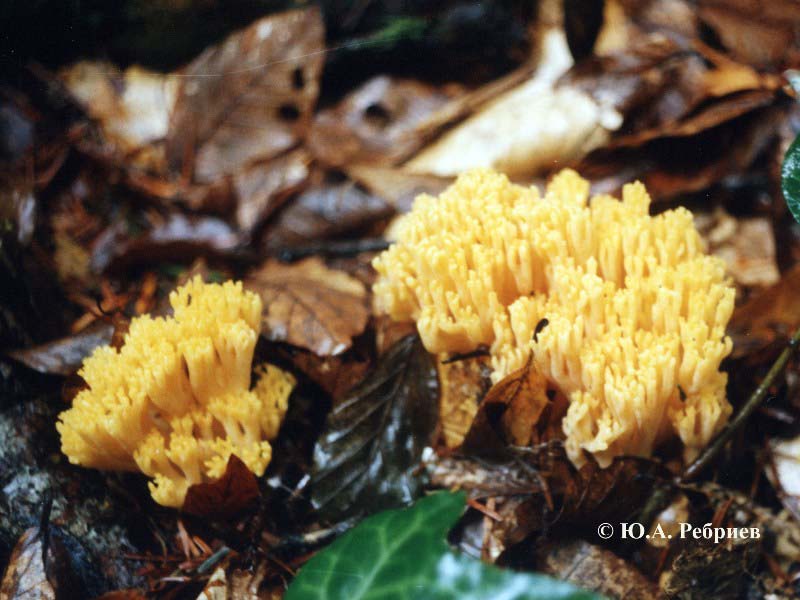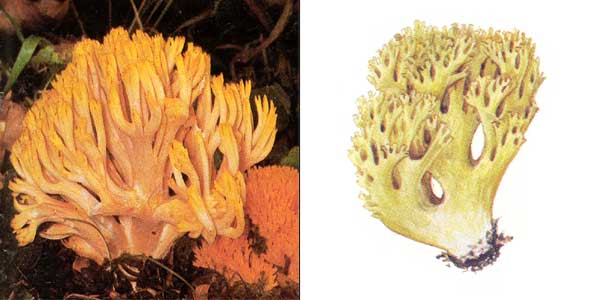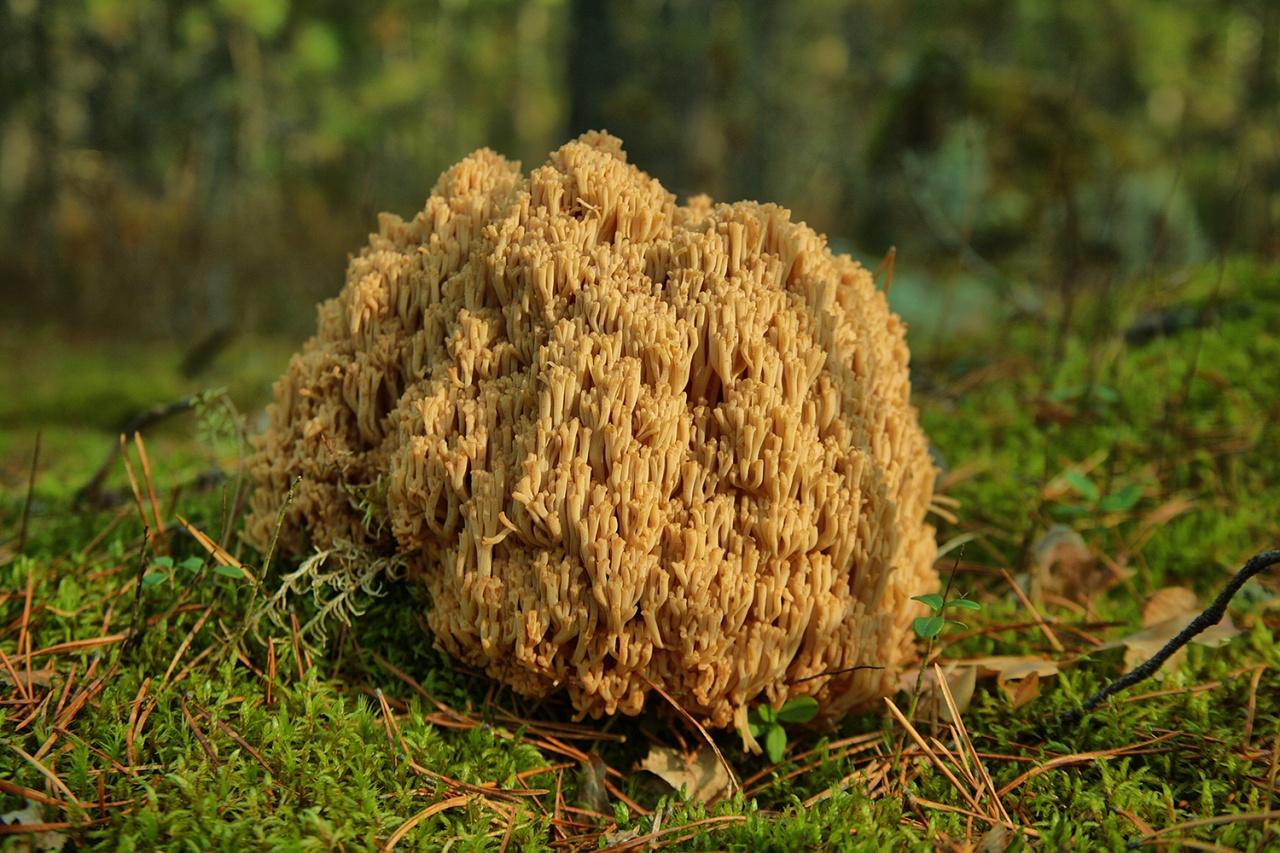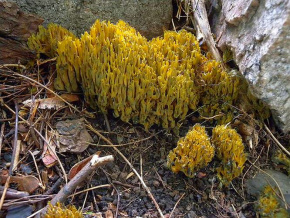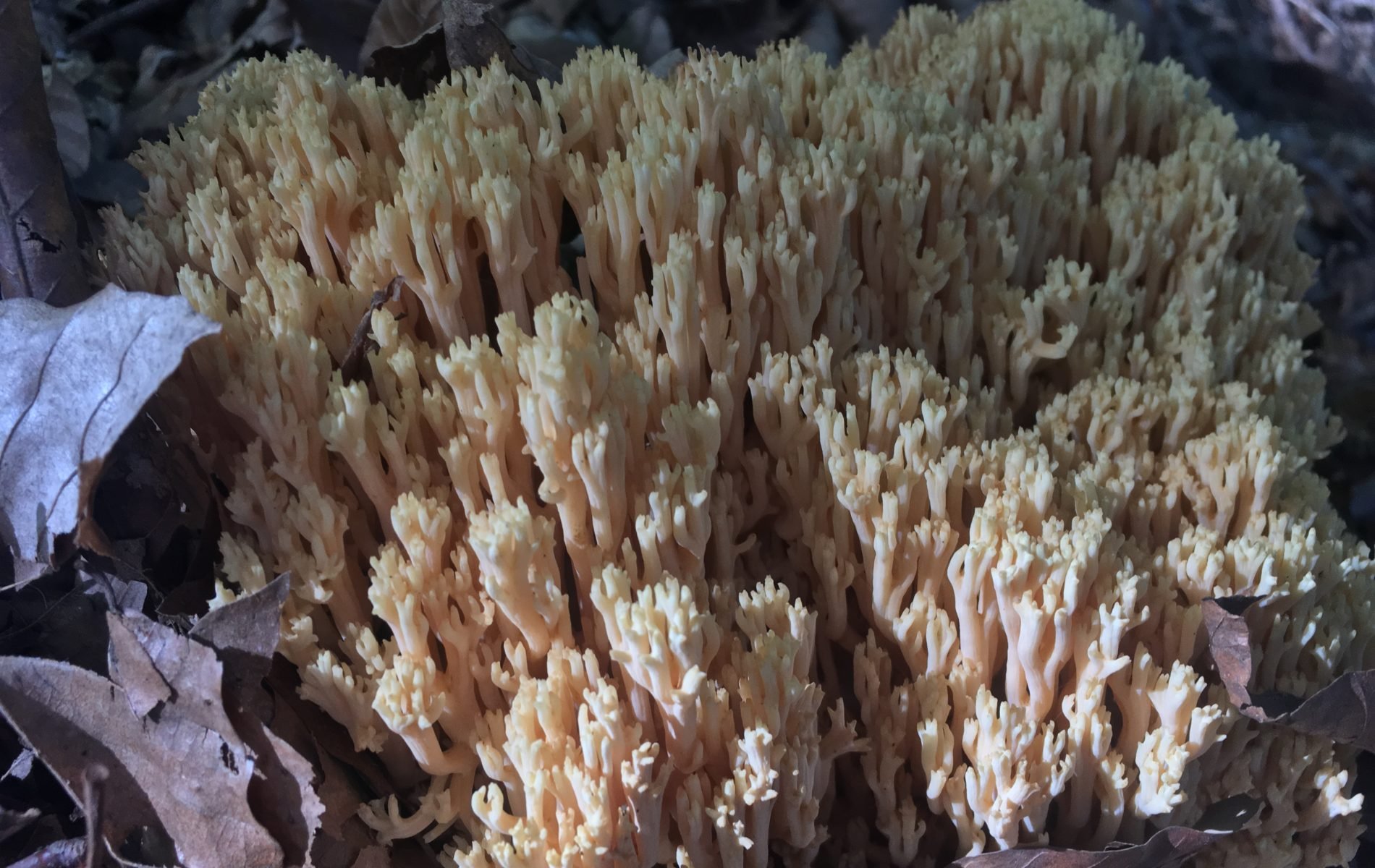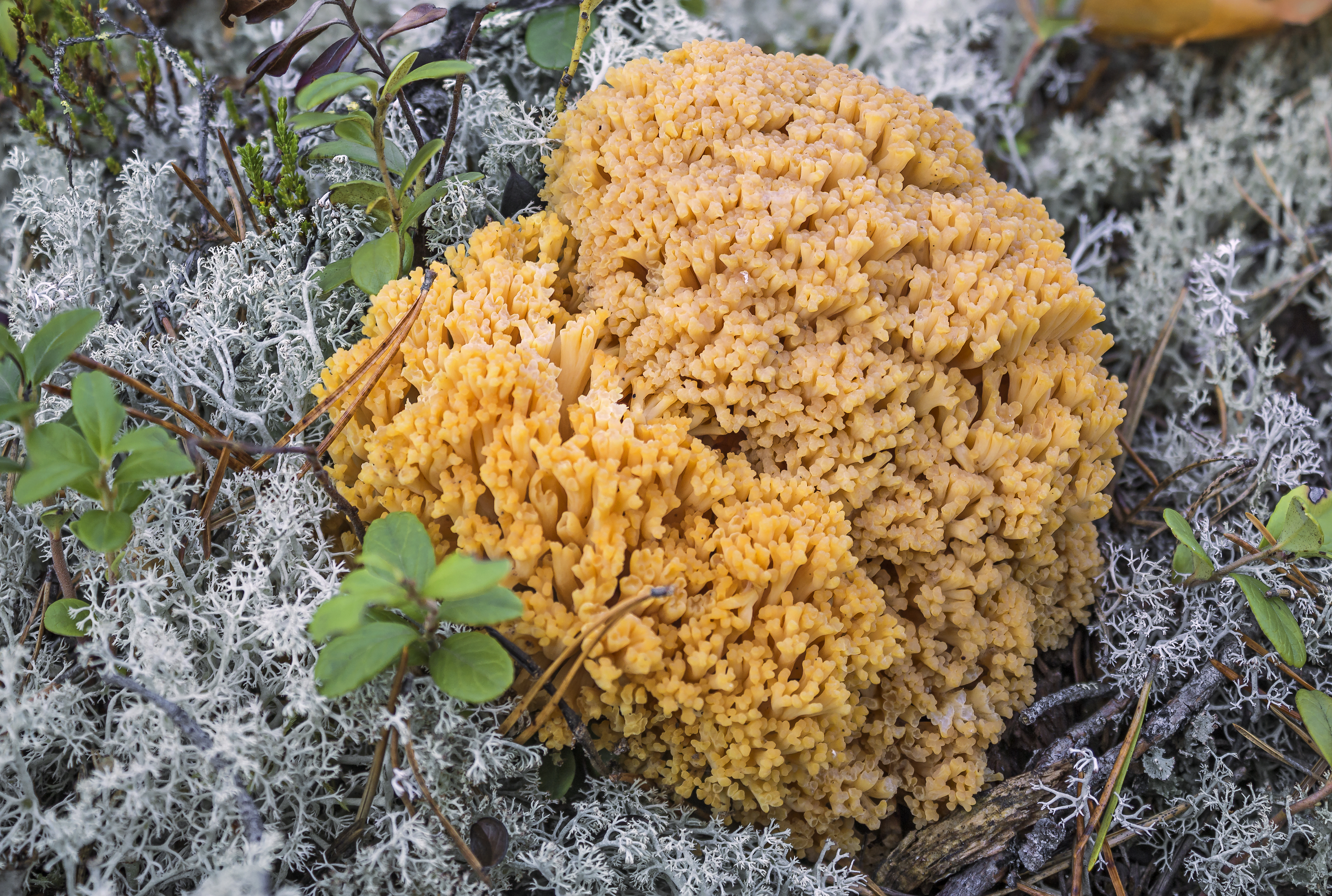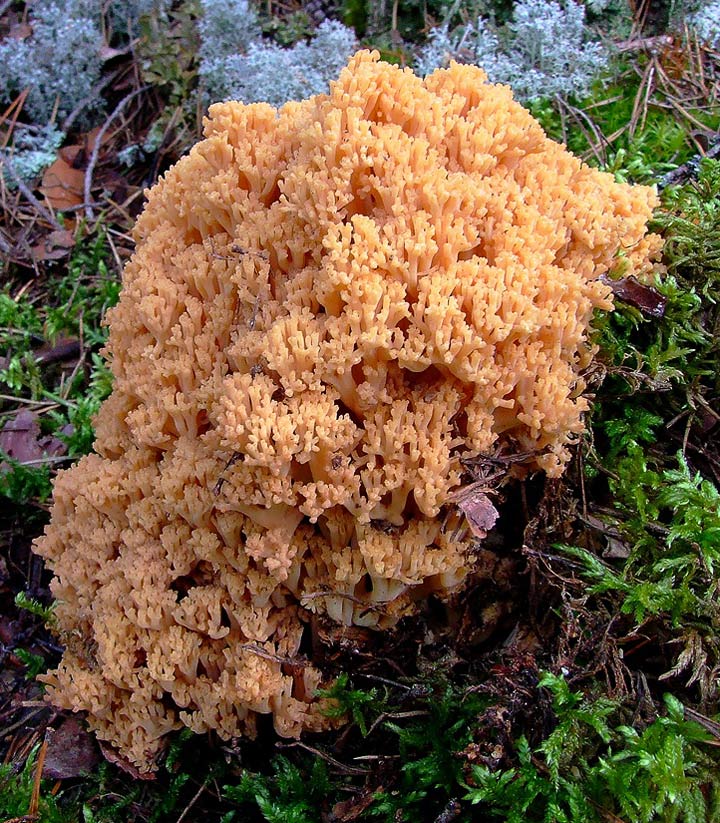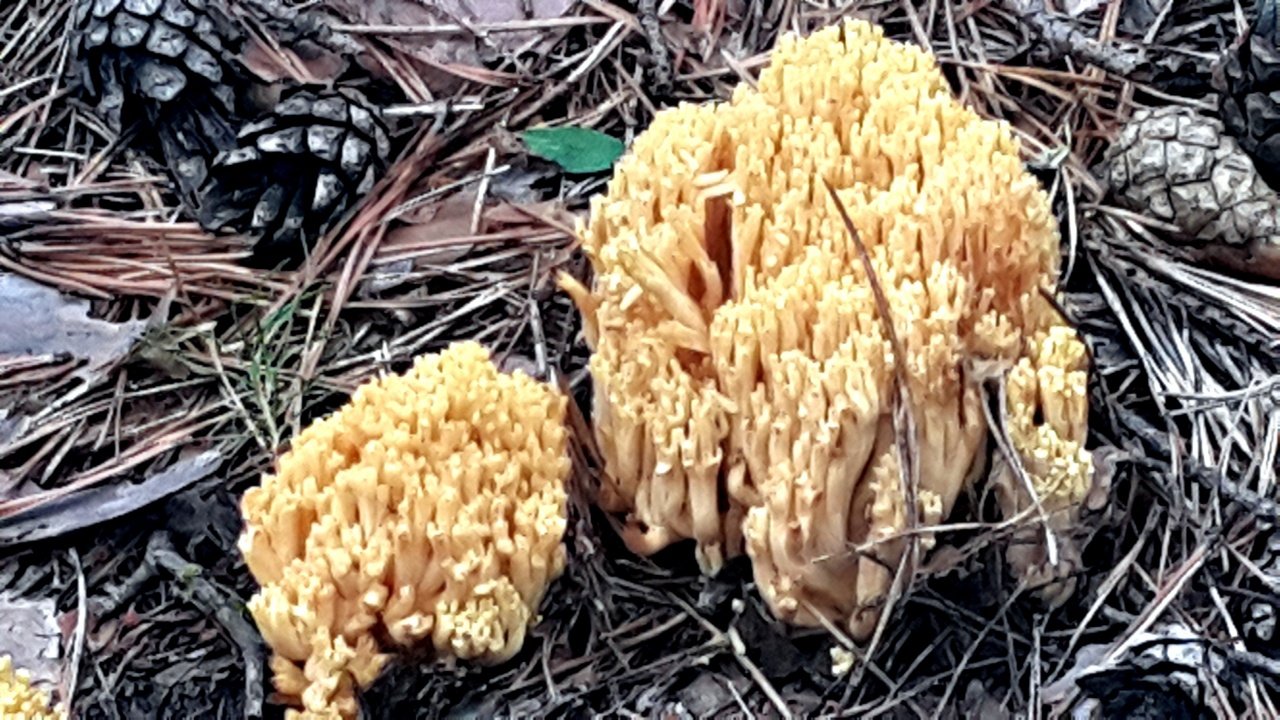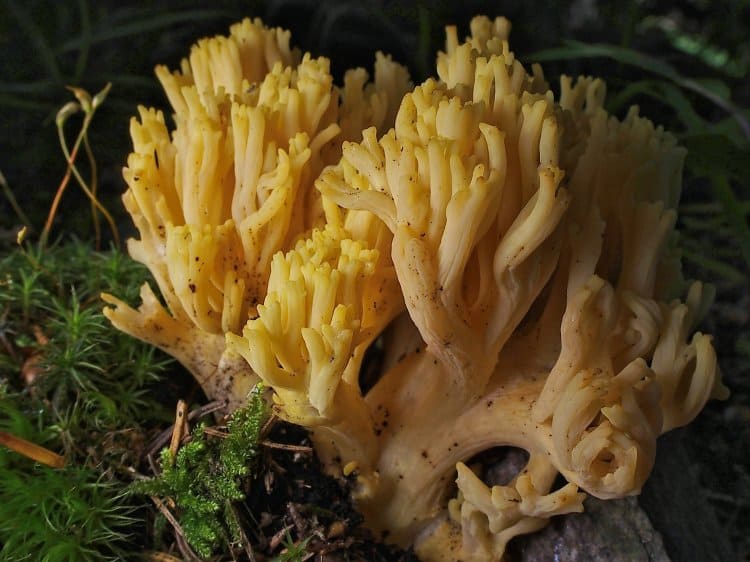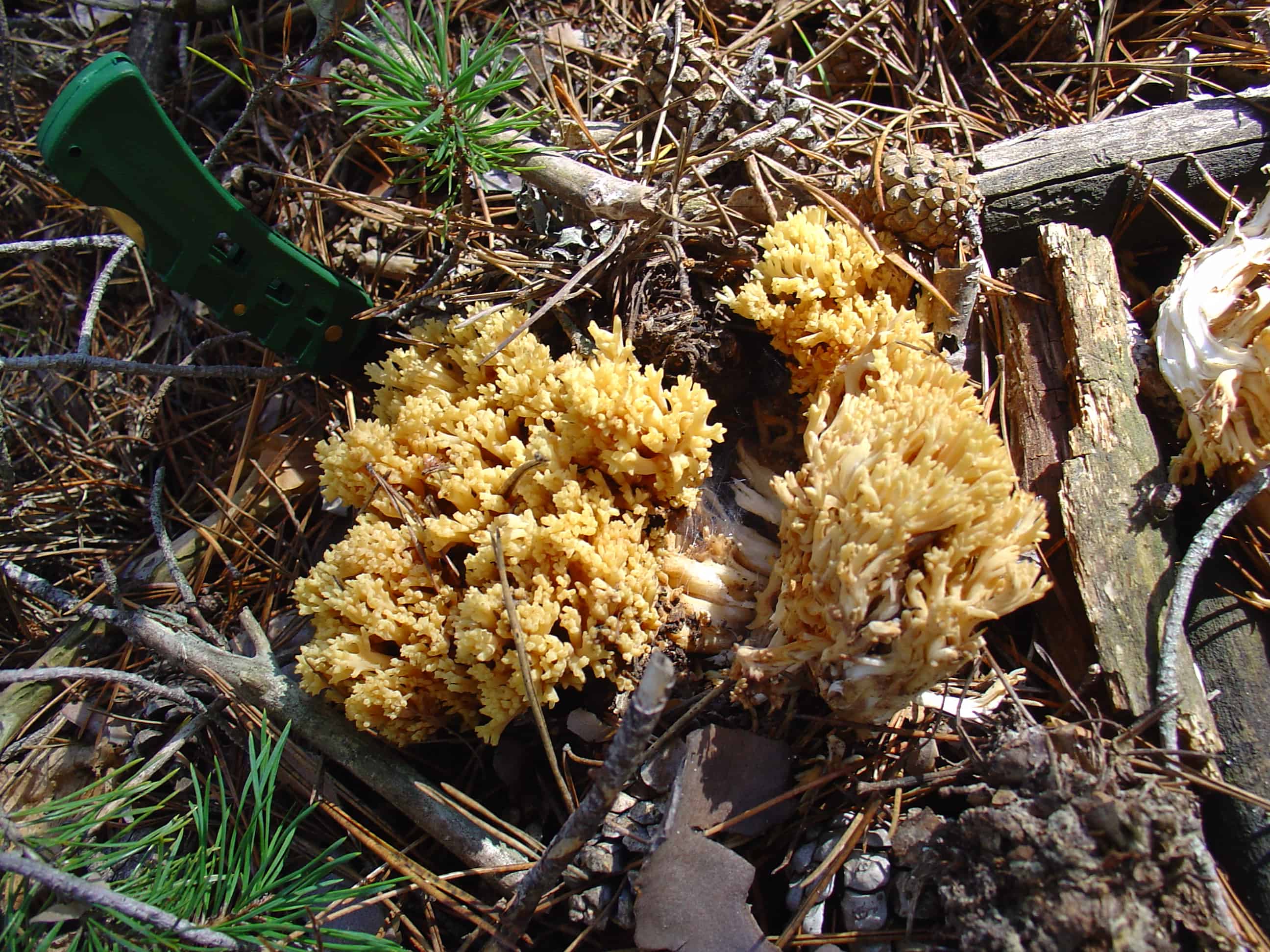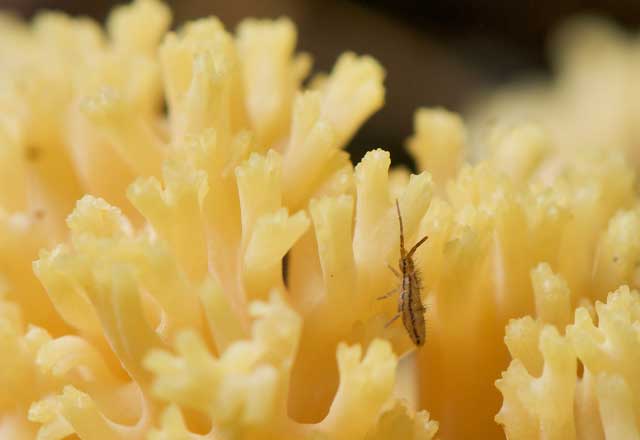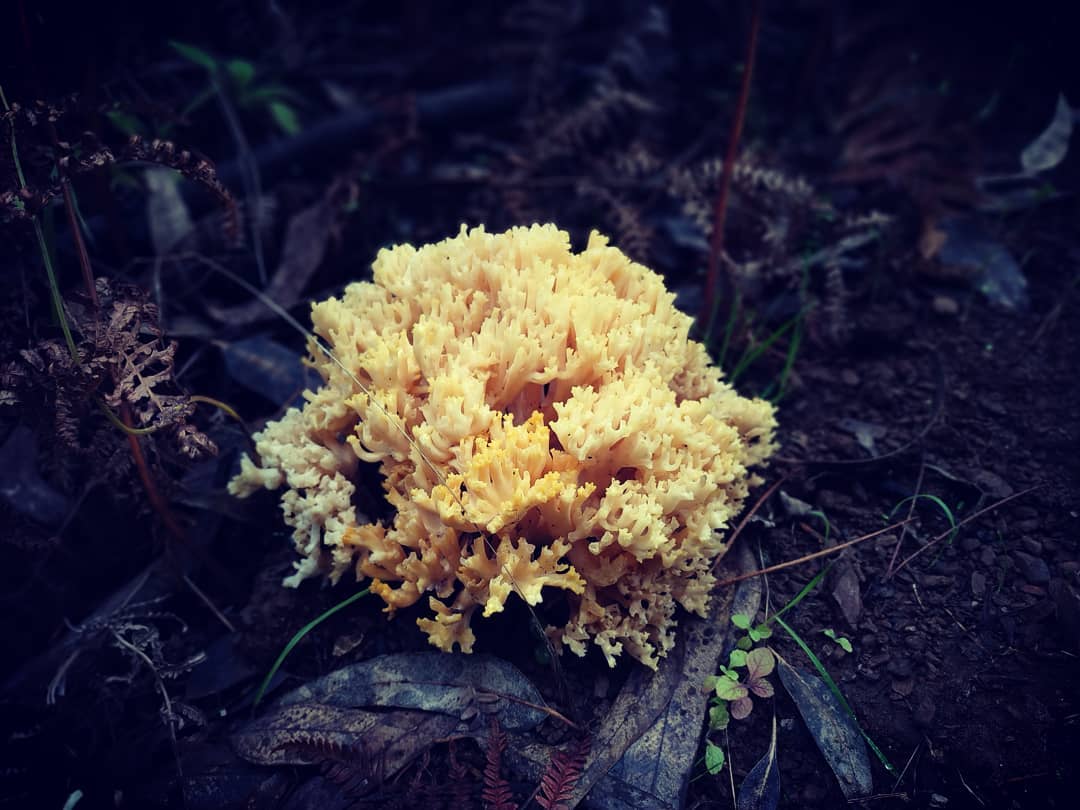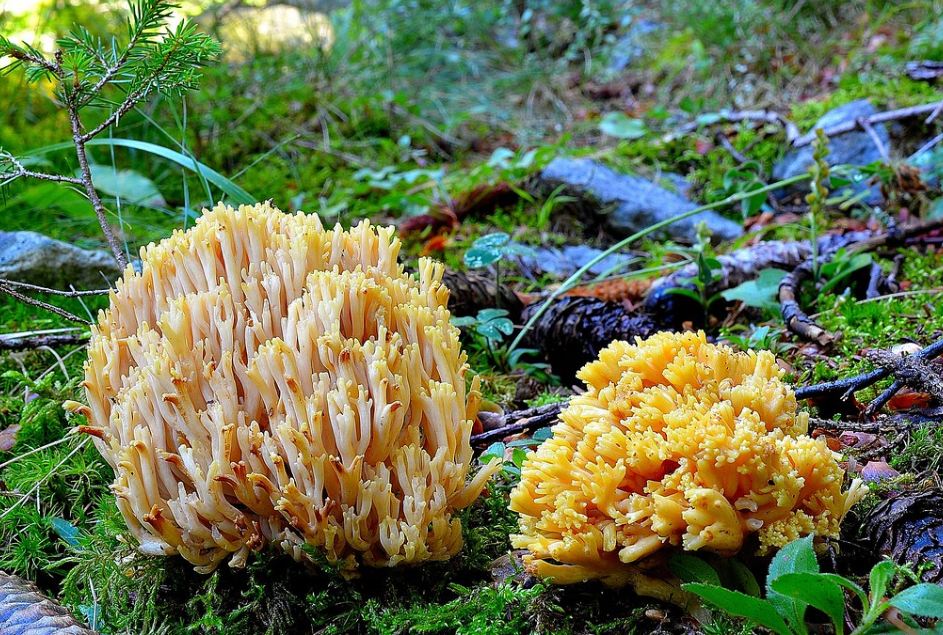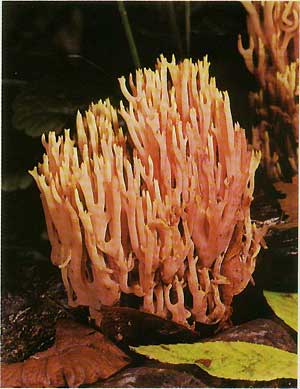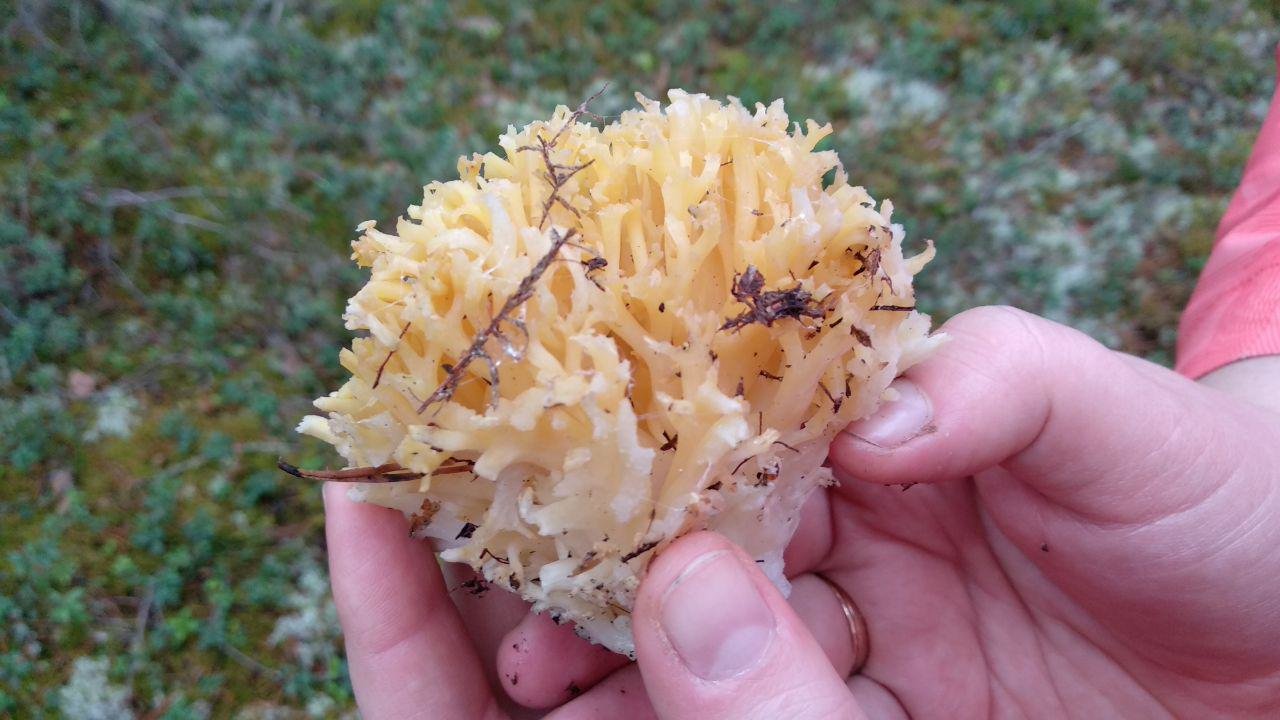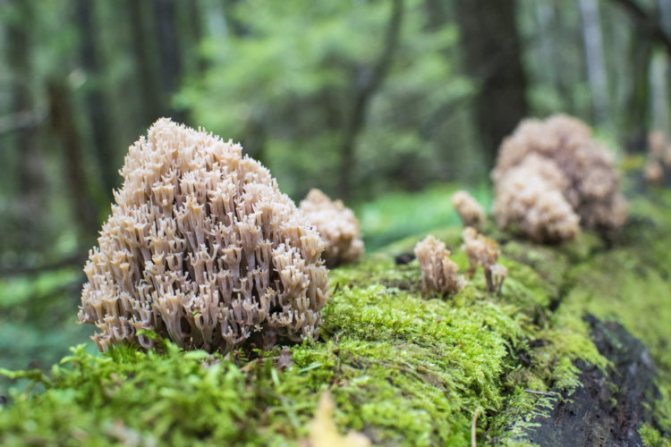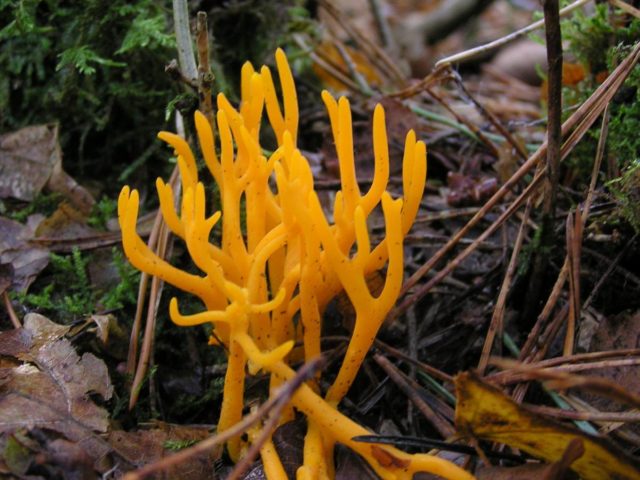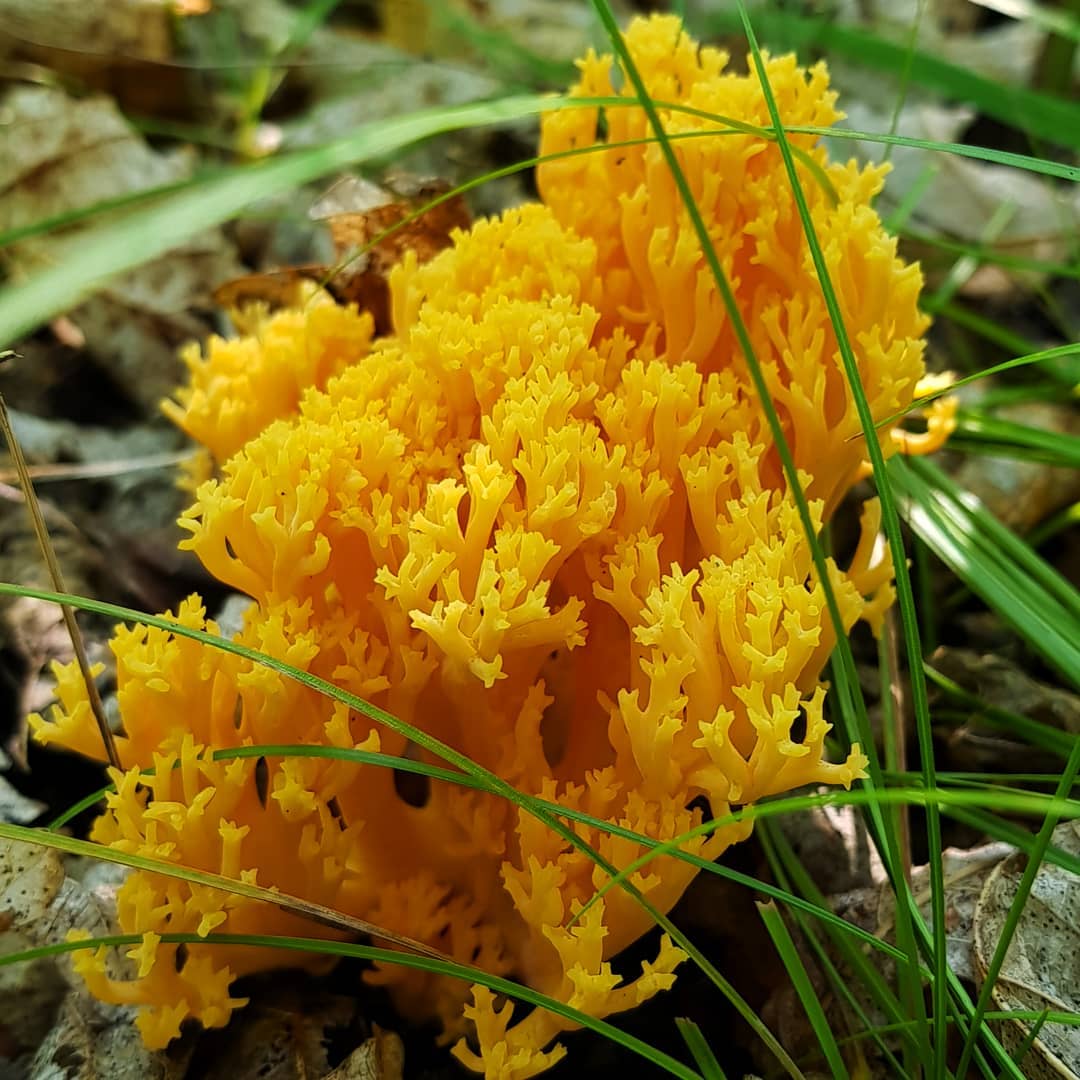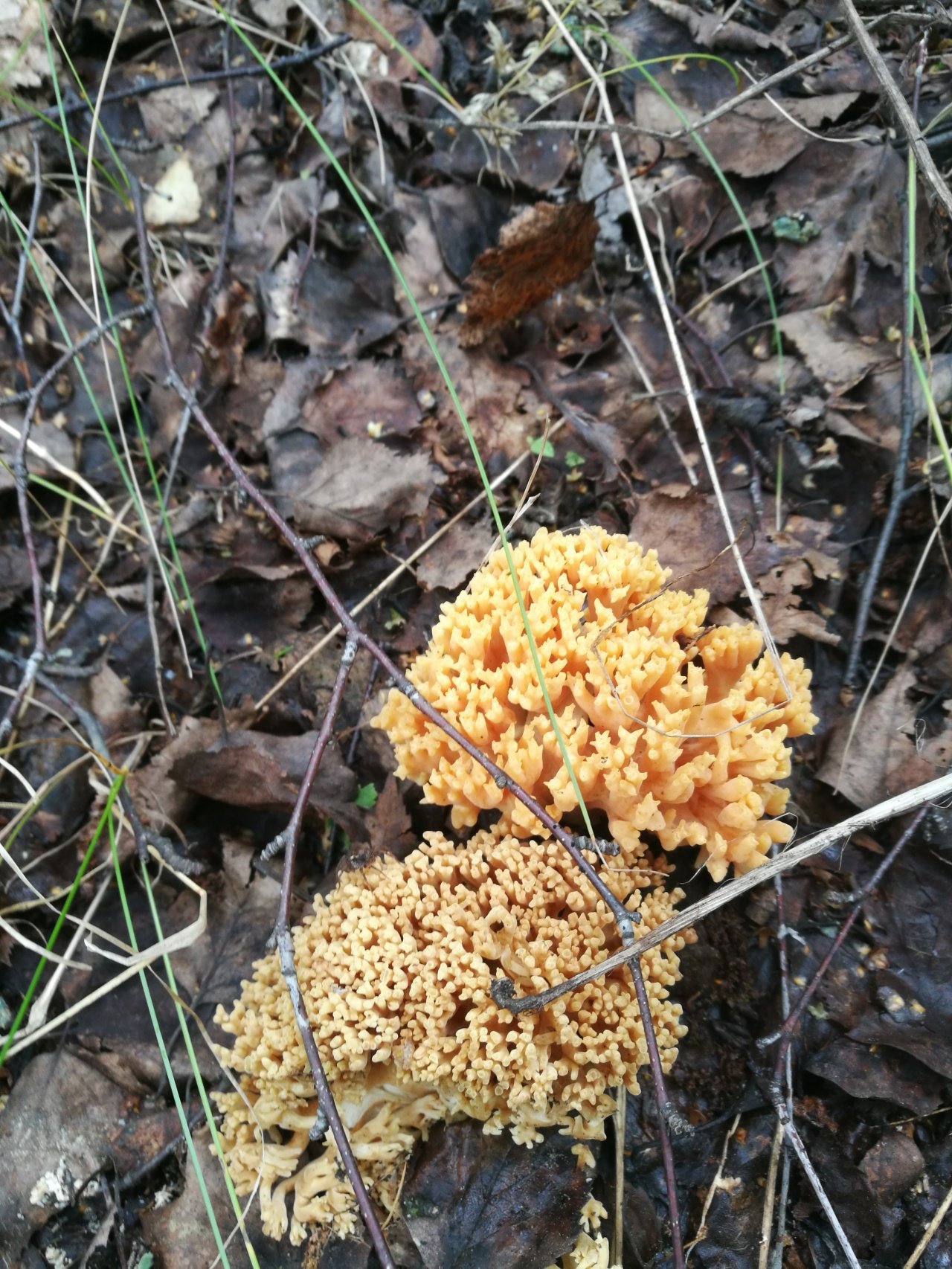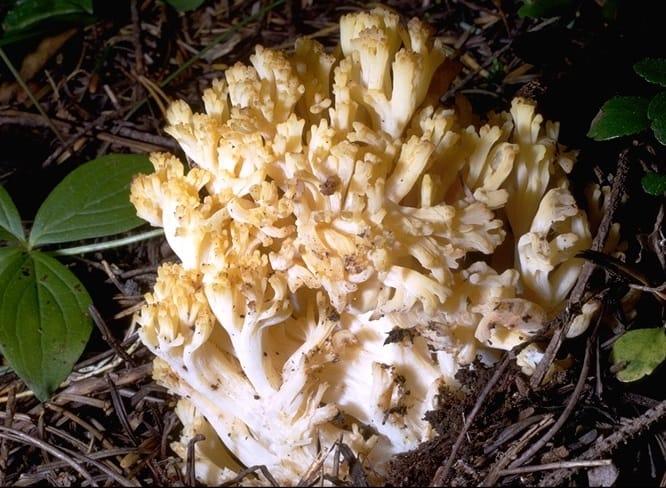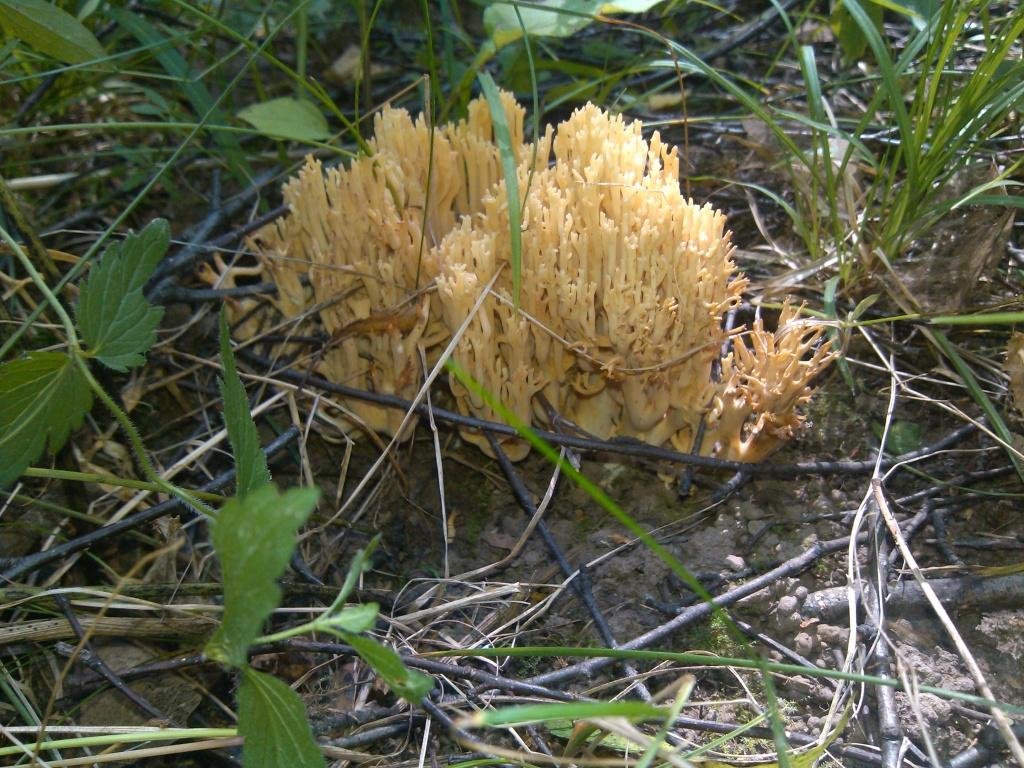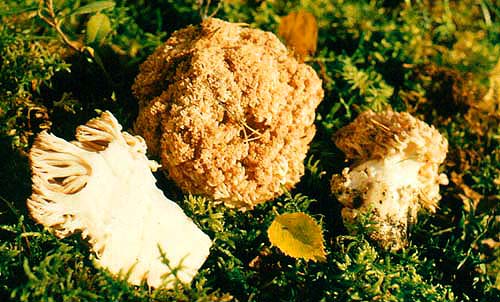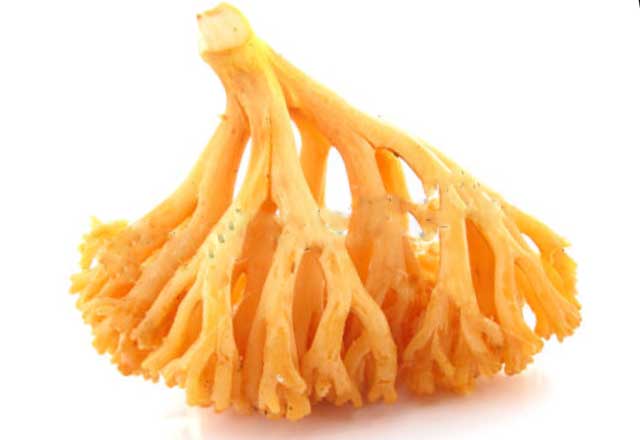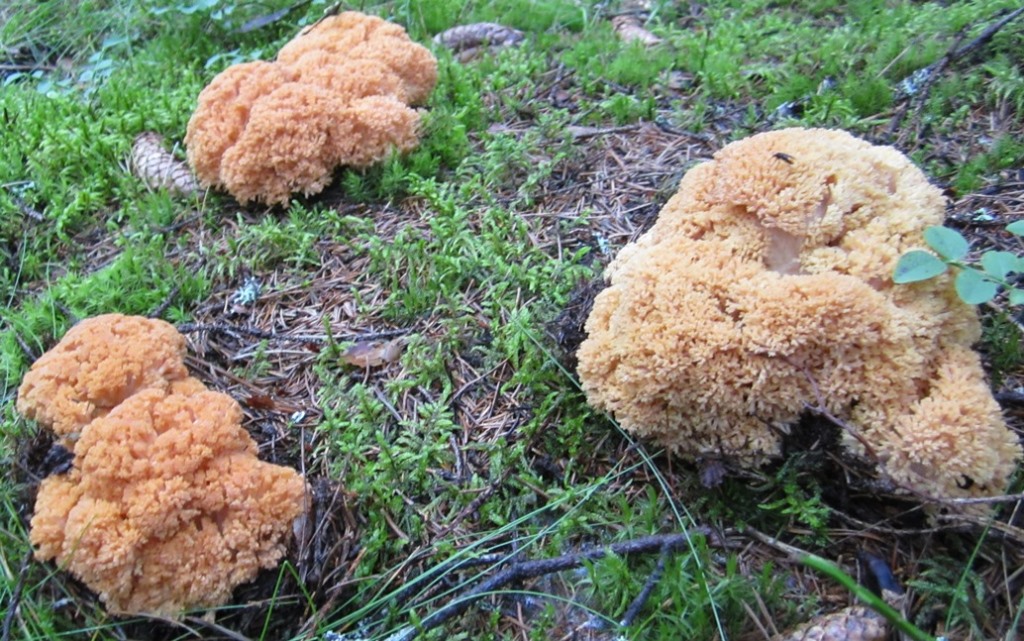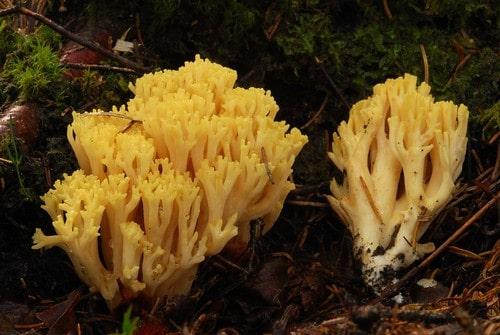Views
These organisms are divided into edible and inedible. There are no horns dangerous to human life and health. For a mushroom picker, edible horned mushrooms are a real find if you know how to cook them correctly. These mushrooms are relatives of chanterelles.
Edible species include:
- golden;
- amethyst;
- aciniform;
- yellow;
- truncated;
- reed.
Inedible species:
- fusiform;
- comb;
- pale yellow;
- purple;
- pistillate
- fistful;
- straight.
Edible baby horned mushrooms are pleasantly scented and easy to cook. Most often they give a large harvest.
Reed horn
The reed horn (Clavariadelphus ligula) is an edible species with a pale yellow tint. It belongs to saprophytes of the 4th category of edibility.
Its branches are in the form of a cylinder, thin, widened at the bottom. The appearance resembles a human tongue sticking out of the ground, hence the name. The reed horned grows in coniferous forests in whole groups in the form of circles, which the foresters call witch.
Their size is small, up to 10 cm in height. The collection begins at the end of summer.
Ramaria
Forest corals - this is the name of ramaria, which grows in pine forests. Its trunk is incredibly beautiful and looks like a branchy marine organism that accidentally got into the forest thicket. The appearance of ramaria is characterized by:
- dichotomous trunk;
- white color of the inner layer;
- hymenial surface (having spores);
- yellow.
With age, ramaria changes color to orange-red. It is believed that chanterelles and horned ones have common ancestors, so they have a certain similarity in structure.
Ramaria forms mycosis with spruce and pine. It can be eaten, but it has a bitter taste, so it should be harvested at the end of August and September, since young ramaria tastes less bitter.
Beautiful horned
It is a poisonous mushroom that grows in deciduous and mixed forests. It is characterized by:
- height - 20 cm;
- diameter - 18-20 cm;
- short, thick and dense leg;
- bright pink color in young organisms.
Old ramarias become whitish, branch strongly at the bottom, the tips of the branches first turn yellow, and then brown or brown.
Eating food leads to disruption of the gastrointestinal tract.
Comb slingshot
An inedible forest organism that bears fruit in conifers, deciduous and mixed forests from the second half of July to the end of October. Grows in groups of bushes. It has a comb-like shape and a cream or white body color, at the base of which there is a thick, dense leg.
The pulp has a characteristic bitterness. She is fragile and delicate, without a bright aroma.
Ramaria ordinary. How to distinguish straight slingshots
Straight catfish can be confused with Calocera viscosa. On closer inspection, significant differences can be found between the species. The color of the gummy calocera is more saturated, almost flashy. The fruit body can have a bright yellow or bright orange hue. The height of the calocera does not exceed 10 cm. Numerous branches branch dichotomously, that is, the main axis bifurcates and stops its own growth. This branching is repeated many times, as a result of which the mushroom becomes like a bush, coral or a frozen fire. Refers to inedible.
Ramaria ordinary (Ramaria eumorpha) is the closest relative of the straight horned. The species are very similar in appearance. The mushroom is distributed throughout the territory of the Russian Federation, where there are coniferous forests. Fruiting from late July to early October. Grows in groups on spruce or pine bedding, often forms so-called "witch circles".
The vertical ramifications of the common ramaria are distinguished by sharper tips relative to the straight ramaria. The fruit body is represented by a dense bush with a height of 1.5-9 cm and a diameter of up to 6 cm.The fungus is uniformly colored in a light ocher or ocher brown color; numerous thorns and warts are present on the surface of the branches.
Comment! Considered a conditionally edible product with low palatability. It is eaten after prolonged soaking followed by boiling.
Artomyces pyxidatus can also be mistaken for a straight horn. The species has vertical coral-like ramifications. The fruit body is colored ocher-yellowish calm color. The clavicorona can be distinguished from the straight clavicoron by its size: sometimes it grows up to 20 cm in height. Another difference is the characteristic crown-shaped tips, which from a distance resemble the crenellated towers of a medieval castle. The habitats of the species are also different. In contrast to the straight slingshot, the capillary clavicorona loves to grow on decaying hardwood, especially on old aspen logs.
Amazing ramaria
On a rotten tree, which is not particularly pleasant to look at, one finds amazingly beautiful corals - fragile and photogenic. It would seem completely inappropriate on these rotten ones. The words of Anna Akhmatova are immediately remembered: "If only you knew from what rubbish poetry grows without knowing shame!"
Ramaria golden
Beauty is born from dust, the living from the dead, fragile from the gross. But if you digress from poetry and philosophy and look at this miracle from a culinary point of view, you can see a delicious conditionally edible mushroom, popularly called yellow coral, mushroom cabbage or deer horns, and in science - golden ramaria.
If you come across a young mushroom of golden color, you can safely put it in the basket: in the marinade, in the soup, and as a roast - a very tasty mushroom. The main "stump" of a young mushroom (it is white) after boiling seemed to me even sweetish.
The older the mushroom, the more bitterness it contains. Starting with twigs. Perhaps that is why there are references to the conditional edibility of this mushroom and the need for boiling with a drain of water.
A mushroom of numerous branches growing from one base can weigh more than 2 kilograms. I, however, did not come across more than 0.5 kg. But often the mushroom is found in heaps. With age, it becomes bitter, "rubbery" and inedible.
The age is indicated by a change in color in a fairly wide palette: from grayish-yellow to brown-orange. Either golden ramaria or yellow ramaria can be found throughout the forest zone. Only mycologists can see the difference. And even then under a microscope.
Ramaria golden (Ramaria aurea). Tatiana Nikolina
Ramaria is beautiful
In pursuit of edible horns, a beautiful ramaria, even more attractive, more rare, but inedible due to bitterness and unpleasant gastrointestinal consequences, can insidiously fall under the arm.
It has pink tones, the base, branches and branches at the tips are colored differently. A kind of design approach with a hint of a photo shoot. Glamorous beauty. Turns pink when palpated. It is better not to rip off, but to limit yourself to groping and photographing.
Ramaria ordinary
The simplest ramaria is simply called ordinary. In comparison with the previous ones, it is really simpler. But it is found in the temperate zone more often mainly on coniferous litter and is very abundant. Sometimes not just a family, but a whole diaspora.
Moreover, it grows, at times, in the form of a braid, or in an arc, or in a row, or a complete "witch's ring". He dabbles in geometry.
It is difficult to confuse it with other mushrooms, its branches are straight, without any frills at the tips. And the color from root to crown is the same, not changing when damaged.
It is necessary to collect young specimens. To remove bitterness, soak for a day with 2-time change of water or boil, drain the water. Bitterness, just like in golden and yellow horned horns, is gained with age, but, unlike them, there is a starting bitterness.
Ramaria uviform
But not everything is so arbitrary with edibility in the ramaria family, there are also representatives there with outstanding culinary properties, for example, ramaria uviform.
Also very beautiful, with pink-colored twigs. Only the twigs are shorter, thicker and have a very massive base. A sort of donut. The structure of the twigs is similar to cauliflower. Pleasant smell and pleasant taste, no need to suffer with soaking and preliminary boiling, you can immediately fry or cook without draining the water.
Edible, while the twigs are pink-red, browning indicates the onset of inedible old age.
Unfortunately, it is less common, loves warmth (both in terms of degrees and in terms of regions), an individualist - she does not grow up in large families.
Ramaria uviform (Ramaria botrytis). Michael Wood Beautiful Ramaria (Ramaria formosa). Punkufer Ramaria stricta. wikigrib
Inedible ramaria
There are still inedible representatives in this family, but deserving attention and photographing: ramaria is stiff, slender and straightforward, with parallel growing branches and turns red / brown when pressed. Initially bitter.
Ramaria is ocher-green in lime shades in youth, rapidly blue / green when damaged. It is rarely found, mainly on litter in coniferous forests. Bitter.
This mushroom, strictly speaking, is not particularly ramaria. At first, the mushroom was attributed to the genus Clavaria, then to the Ramaria, and now it is called Theoklavulina fir. A slingshot walking through the sections.
Feoklavulina fir, or Ramaria ocher-green (Phaeoclavulina abietina). H. Krisp
Precautionary measures
There are many plants that look like deer legs. Many of them are quite poisonous. Therefore, if you are new to this business, then ask an experienced mushroom picker to tell and show how to correctly collect and distinguish deer legs from other plants.
Remember that after harvesting, before cooking, you must rinse and process them well, because if not cooked correctly, they can have a serious negative effect on your body.
Do not harvest near the pistes, as the plants quickly absorb toxic substances.
The mushroom is considered edible, however, it is not noticed in mass preparations, what to do with it is not clear, but the mushroom is noticeable and you simply cannot pass by.
Let's go together (1)
Reed horn (lat.Clavariadelphus ligula) is an edible mushroom from the genus Clavariadelphus. This mushroom is also called truncated horned, claviadelfus reed, mace and hind tongue. The fungus is noticeable, the fruiting body is club-shaped, not branching, colored in orange-yellow or cream tones. Butterflies prefer to grow only in coniferous forests, and they settle exclusively under pine trees in mosses, possibly forming mycorrhiza with them. You can find them on the edges, near stumps and tree trunks. Reed horns grow in the litter, in moss, on the remains of wood buried in the soil and in densely fallen needles. Butterflies bear fruit in groups, sometimes huge, meeting in hundreds or more specimens. Fruiting is observed from July to November, while active growth occurs in October. It comes across infrequently, but in large groups.
The mushroom is considered edible, 4th category, with low palatability. Massively these mushrooms are not harvested anywhere, it is not clear what to do with it. Polysaccharides were isolated from the mycelium culture of horned beetles, which stop the growth of Ehrlich's carcinoma and sarcoma-180 by 90%. The mushroom contains melatonin, a serotonin precursor and hydroxytryptophan. These mushrooms are natural antibiotics.
The fruiting body of the reed stalk has neither a leg nor a cap, is vertical, lingual, somewhat widened in the upper part (sometimes up to the shape of a pistil), often slightly flattened; height 7-12 cm, thickness 1-3 cm (in the widest part). The surface of the fruiting body is smooth at first, later becomes uneven, wrinkled. The inside of the mushroom is hollow.
Its base is fleecy-felt. The color of young fruit bodies is cream or yellow, and then becomes ocher-yellow or orange-yellow, old fruit bodies are brown with a purple tint. This shade is most noticeable at the base of the mushroom. The head of the mace is rounded or flattened, its diameter is 0.5-3 centimeters. The head narrows noticeably towards the base. The pulp is light, whitish, dry, without a noticeable odor.
The pulp of the reed stalk at an early age is soft, spongy, tender, elastic, then it becomes dry and brittle. A noticeable purple tint appears at the fracture of the pulp. The pulp does not have a tangible taste and smell, but sometimes it can be bitter. Spore powder is white, light yellow or cream. The spores of this fungus are long, cylindrical in shape.
The reed horn can be confused with other representatives of the genus Clavariadelphus, especially with the more rare (apparently) pistil horned, Clavariadelphus pistillaris. The one is larger and more "pistil" in appearance. From representatives of the genus Cordyceps, a beige-yellow color of fruit chalk can be a good distinguishing feature.
Useful properties of antler mushrooms
Mushrooms, similar to yellow corals, can not only be eaten, but also used for medicinal purposes. They are especially popular in Chinese medicine. Due to the content of phytoagglutinin, amino acids and sterol, the product is often used to normalize the functioning of the gastrointestinal tract and cleanse the lungs. Cosmetologists use deer horns to slow down the aging process. The fungus is also believed to be able to prevent the growth of malignant cells and to strengthen the immune system. Other benefits of a slingshot include:
- prevention of thrombosis by strengthening the vascular walls;
- normalization of the central nervous system;
- stabilization of respiratory function;
- reducing the risk of developing oncology;
- elimination of toxic substances from the body;
- improved blood composition;
- strengthening the immune system;
- beneficial effects on brain function and memory;
- rejuvenation of the skin.
Delicious recipe! Brut wine what is it
Among other things, antlers are considered overly nutritious for the human body. They are 70% dietary fiber. Experts say that the bear's foot is considered one of the most valuable sources of iron and calcium. Thanks to this, the product can be used for the prevention and treatment of various diseases caused by vitamin deficiency.
Ramaria mushroom. Ramaria yellow (Ramaria flava)
An exotic species, nevertheless often found in forests, especially in the Leningrad region, rep. Karelia, the Caucasus, the Far East and Eastern Siberia. People also call it yellow horned, coral mushroom, yellow coral. Gardeners may find this self-growing mushroom mycelium on sale called Mushroom Noodles (from Chinese). Mushroom coral can be found from July to October, mainly in coniferous forests. Prefers damp, shaded places, but often grows abundantly in clearings well-lit by the sun. It can grow singly, in small groups and in large formations in the form of semi-rings.
The bushy yellow horned horn really looks like a piece of coral. It can reach a height of 25-30 cm with a total weight of 2-3 kg. From a thick base (which can be called a leg), numerous, sequentially bifurcating branches extend. They are of equal length (relatively long), strongly branched, bushy, fleshy, cylindrical or flattened, smooth, with blunt, irregularly truncated or serrated (often double) ends. At a young age, the twigs are yellow, in a more venerable one they can be painted in any shades of yellow: yellowish, apricot, lemon, sulfur, dirty pale and gray-yellow, golden ocher or creamy, at maturity - ocher or orange ...Closer to the so-called stalk, the fruit body is sulfur-yellow. The base itself is thick, 2 to 8 cm high, 4 to 5 cm in diameter, tapering downward. It is dense, whitish or yellowish in color (usually monochromatic with branches). It can be covered with reddish spots of various sizes or darkens upon pressure (to a reddish or wine-brown color). The pulp is white, off-white or yellowish, as if marbled in the stem, does not change color at a break or becomes reddish-brown. Watery, with a pleasant, slightly grassy odor, in youth it is fragile, soft, with a pleasant or insipid taste, with age it begins to taste bitter (especially the tops) and becomes rubbery.
Can be confused with other types of ramarias:
- golden (has a whitish base and shorter branches);
- with a weakly poisonous beautiful tricolor ramaria (it has yellow and ocher-brownish branches (the main ones with a pinkish tinge), with a bright pink leg in youth and whitish in maturity, with a slightly bitter pulp);
The mushroom is edible. Young sprigs of slingshot are especially tasty in mushroom soups. You can salt (before salting, you need to pre-boil for 10 minutes). In adults, the top of the twigs can be bitter, so they are usually removed.
Views
These organisms are divided into edible and inedible. There are no horns dangerous to human life and health. For a mushroom picker, edible horned mushrooms are a real find if you know how to cook them correctly. These mushrooms are relatives of chanterelles.
Edible species include:
- golden;
- amethyst;
- aciniform;
- yellow;
- truncated;
- reed.
Inedible species:
- fusiform;
- comb;
- pale yellow;
- purple;
- pistillate
- fistful;
- straight.
Edible baby horned mushrooms are pleasantly scented and easy to cook. Most often they give a large harvest.
Reed horn
Horned animals begin to collect at the end of summer
The reed horn (Clavariadelphus ligula) is an edible species with a pale yellow tint. It belongs to saprophytes of the 4th category of edibility.
Its branches are in the form of a cylinder, thin, widened at the bottom. The appearance resembles a human tongue sticking out of the ground, hence the name. The reed horned grows in coniferous forests in whole groups in the form of circles, which the foresters call witch.
Their size is small, up to 10 cm in height. The collection begins at the end of summer.
Ramaria
Forest corals - this is the name of ramaria, which grows in pine forests. Its trunk is incredibly beautiful and looks like a branchy marine organism that accidentally got into the forest thicket. The appearance of ramaria is characterized by:
- dichotomous trunk;
- white color of the inner layer;
- hymenial surface (having spores);
- yellow.
With age, ramaria changes color to orange-red. It is believed that chanterelles and horned ones have common ancestors, so they have a certain similarity in structure.
Ramaria forms mycosis with spruce and pine. It can be eaten, but it has a bitter taste, so it should be harvested at the end of August and September, since young ramaria tastes less bitter.
Beautiful horned
It is a poisonous mushroom that grows in deciduous and mixed forests. It is characterized by:
- height - 20 cm;
- diameter - 18-20 cm;
- short, thick and dense leg;
- bright pink color in young organisms.
Old ramarias become whitish, branch strongly at the bottom, the tips of the branches first turn yellow, and then brown or brown.
Eating food leads to disruption of the gastrointestinal tract.
Comb slingshot
An inedible forest organism that bears fruit in conifers, deciduous and mixed forests from the second half of July to the end of October. Grows in groups of bushes. It has a comb-like shape and a cream or white body color, at the base of which there is a thick, dense leg.
The pulp has a characteristic bitterness. She is fragile and delicate, without a bright aroma.
Characteristic features of the variety
The coral's botanical name is Ramaria yellow, which belongs to the Horned family. The slingshot shape resembles branched deer antlers or underwater coral.
Description of deer horns and photo of a mushroom
The photo clearly shows that the ground part of the deer antlers mushroom is very branched.
Its color depends on several factors:
- habitats;
- climate features;
- age.
Branches can be colored beige, light brown, light yellow, orange or purple. Basically, the height of the fruit body does not exceed 7 cm, but the width varies from 15 to 30 cm. When pressed on the fruit, a light brown tint appears. The cuticle has a marbled yellow color. The mushroom has a pleasant aroma that resembles the smell of freshly cut grass.
Morphology
The tops of old horned horns accumulate substances that give it a bitter taste. Therefore, the upper branches are not used for food. The mushroom itself differs in taste from its congeners, because it does not have a pronounced mushroom taste. Raw slingshots are quite elastic, and after cooking they become harsh.
Very similar to golden-yellow ramaria hedgehogs. The differences between these specimens can only be seen under a microscope. Nothing terrible would have happened if you cut off the double, because both ramaria are edible.
Place of distribution
This species is extremely rare. You can find such a treasure in the regions of the Far East, Karelia, the Caucasus, Western and Eastern Siberia, as well as in the Crimea. Most of the inhabitants of the central part of our country do not even know about the existence of such "forest bread".
This is due to the peculiarities of the growth of horned beetles. They live in humid and shaded places. Most often they can be found in a pine or deciduous forest, where the most valuable specimens grow.
Edible or inedible
Horned beetles are both edible and inedible. In this regard, you should carefully study the yellow ramaria so that you can distinguish it from other relatives. All black man's twins are moderately poisonous or conditionally edible, so eating them cannot be fatal.
Ramaria yellow is an edible mushroom, but it is important to follow some precautions before eating. Only the base is used for cooking, because the branches have a bitter taste. Overripe fruits are considered unusable due to the large accumulation of bitterness
Overripe fruits are considered unsuitable due to the large accumulation of bitterness.
Description of the appearance of the mushroom
Reindeer horns are an edible mushroom. Its aerial part has many ramifications and small formations resembling thorns 10-20 mm long. The width of its body is 20-30 cm. There are thin, brittle "ears". Of the parasites, only the wireworm harms him.
The color of the mushroom depends on the phase of its growth. Young antlers are light yellow in color; with age, it darkens and becomes bright orange. It doesn't have the usual mushroom smell.
Irina Selyutina (Biologist):
As a species, the mushroom was described in 1755 by the French botanist Joseph de Tournefort. However, its scientific name is yellow ramaria (Ramaria flava), this species received only 133 g later in 1888 thanks to Lucien Kele, the founder of the French Mycological Society.
Delicious recipe! Honey Cake Custard Recipe
Coral mushrooms, to which this species belongs, are considered basidiomycetes. Their spores are formed on the entire surface of the fruiting body, tk. the spore-bearing layer is located on the outside.
Ramaria, aka deer horns, is found on the surface of the soil and on rotten wood or stumps in all types of forests. You can find fruiting bodies in August-September, with good weather until October. Among the many species, poisonous are not found, but there is a division into conditionally edible and edible. It is best to eat only young organisms because older mushrooms taste bitter.

